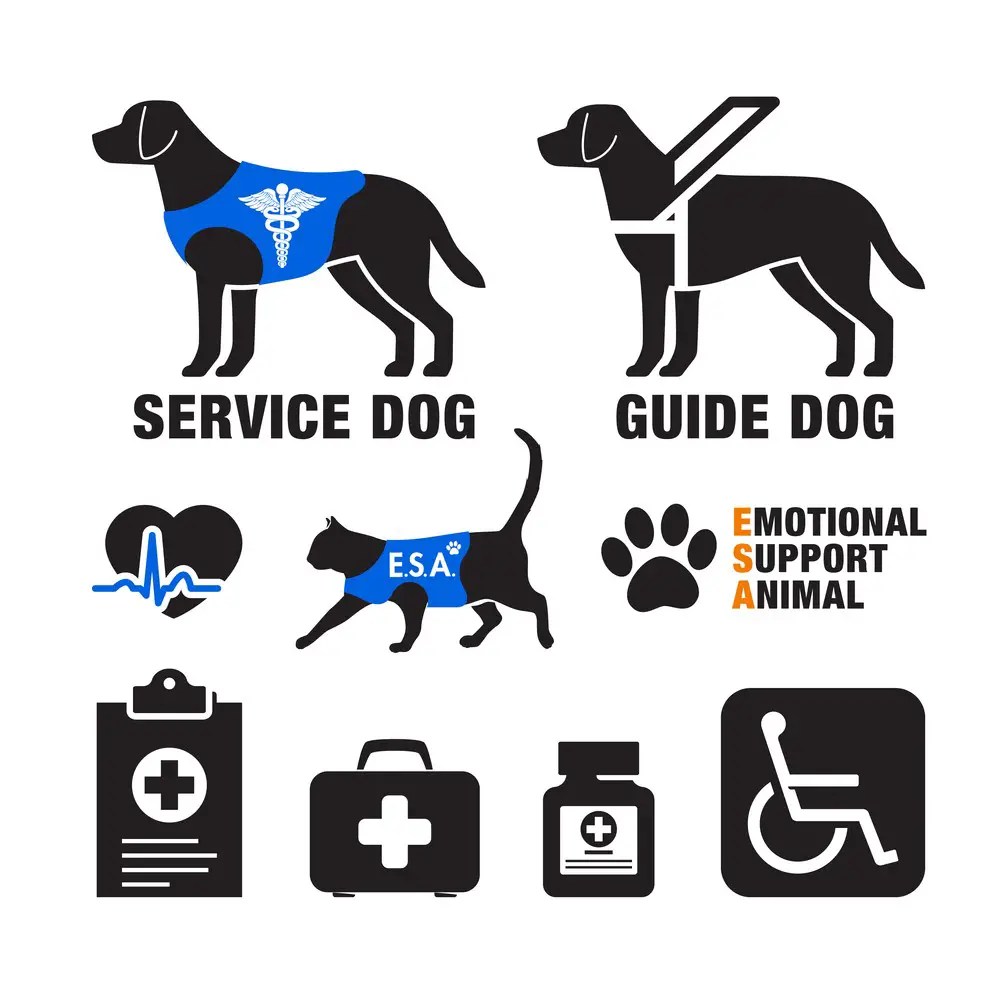As a BetterHelp affiliate, we receive compensation from BetterHelp if you purchase products or services through the links provided
Owning a dog can provide comfort and companionship for many people. However, a dog can play a more significant role in providing emotional support for those struggling with mental health issues. Emotional support dogs are an essential part of many people’s lives, and in this article, we will explore the costs associated with making your dog an emotional support animal.
An emotional support dog is a canine companion that helps individuals cope with mental health disorders, such as anxiety or depression. While they do not require specialized training, they do need a prescription letter from a mental health professional that recognizes the owner’s need for an emotional support animal. This letter is essential for housing and travel accommodations, and it’s important to understand the costs you might incur throughout this process, including obtaining the necessary documentation, training, and overall care of your emotional support dog.
Key Takeaways
- Emotional support dogs provide comfort to individuals with mental health disorders.
- A prescription letter from a mental health professional is required for legal recognition of an emotional support dog
- Costs to consider include obtaining documentation, training, and overall care of your emotional support dog
Understanding Emotional Support Dogs
Emotional support dogs are crucial in providing emotional comfort and companionship to people who need it most. These dogs are specifically known for their abilities to help individuals cope with mental health issues, such as anxiety, depression, or PTSD. With their loyal and loving nature, they can significantly improve the quality of life for their owners.
Unlike service dogs that undergo intensive training to perform specific tasks, emotional support dogs don’t necessarily need specialized training. However, they should still be well-behaved, friendly, and comfortable around people. It’s essential to ensure your dog has basic obedience training if you want them to become an emotional support animal (ESA).
Having your dog recognized as an ESA can bring many benefits, such as more accessible access to housing that may have pet restrictions and even the ability to accompany you on flights. To legally involve your dog as an emotional support dog, you’ll need a prescription letter from a licensed mental health professional stating that your dog provides necessary emotional support.
When considering the cost of making your dog an emotional support dog, expect to invest in the following areas:
- Basic obedience training: Ensuring your dog is well-behaved and responsive to commands.
- Prescription letter: Getting a letter from a licensed mental health professional can cost between $75 to $200, depending on the provider.
- Equip your dog with an ESA identification kit, which includes an ESA ID card and vest, ranging from $20 to $100, depending on quality and accessories.
Remember to do thorough research and choose reputable providers for ESA-related services. Be wary of online scams that promise quick certification without proper evaluation by a licensed professional.
Key Takeaway: Emotional support dogs provide their owners valuable emotional comfort and companionship. It’s essential to understand the basics of becoming an ESA, including expected costs and legal requirements, to help you and your dog live a fulfilling life.
Legal Factors in Owning an Emotional Support Dog

When owning an emotional support dog, it’s essential to understand the legal aspects involved. This will help you better navigate your rights and responsibilities as a handler.
One primary law that protects emotional support dogs is the Air Carrier Access Act. This act allows emotional support animals to accompany their handlers on flights without additional fees. However, airlines may have specific documentation requirements, so checking with your airline before traveling is wise.
Another law to be familiar with is the Fair Housing Act. This act ensures that landlords cannot discriminate against tenants with disabilities, including those who have an emotional support animal. If you have an ESA letter from a licensed mental health professional, your landlord must make reasonable accommodations for you and cannot charge additional fees.
It’s important to note that the Americans with Disabilities Act (ADA) does not provide the same protections for emotional support animals as service animals. Emotional support dogs do not have the same public access rights as service dogs, meaning they may not be allowed in specific public spaces, such as restaurants or stores.
Regarding registration, there is no official registry for emotional support dogs. However, having an ESA letter from a licensed mental health professional is crucial, as it legally validates your need for the dog and helps when dealing with landlords or air travel.
Remember, as a handler, you must ensure your emotional support dog behaves properly in public and does not pose a danger to others. Additionally, remember that different jurisdictions might have specific regulations, so always be aware of any local laws or restrictions that may apply in your area.
Choosing the Right Dog

When deciding to make your dog an emotional support animal, it’s essential to consider the breed, size, and temperament of the dog that will best suit your needs. Here are some key points to consider:
- Breed: Different breeds have various characteristics that make them suitable for emotional support. For example, Labrador Retrievers, Golden Retrievers, and Poodles are often chosen for their friendly and gentle nature. On the other hand, Shih Tzus are excellent cuddle buddies, perfect for providing comfort during anxious moments.
- Size: The size of your dog may also influence how successful they are as an emotional support animal. Small to medium-sized dogs are often preferred as they can handle and transport easily. However, larger dogs may give some individuals a stronger sense of security.
- Temperament: An emotional support dog must have a calm and patient temperament and handle stressful situations effectively. They should also adapt to various environments and be comfortable around other people and animals.
- Personality: Choosing a dog that matches your personality is essential, as you’ll be spending a lot of time together. A playful, energetic dog may be an excellent match for an active person, while a more laid-back dog might better suit a relaxed lifestyle.
To find the perfect emotional support dog, consider contacting a reputable breeder or visiting your local animal shelter, where rescue dogs often need a loving home. It’s a good idea to spend time with the dog before deciding to ensure that you’re compatible.
In summary, choosing the right emotional support dog involves considering the breed, size, temperament, and personality best fits your needs. Take time to find the perfect companion; you’ll have a loyal and supportive friend for years.
Training for Emotional Support Dogs
Training your dog to become an emotional support animal can be rewarding. Although ESAs don’t require the same level of training as service animals, they still need to be well-behaved and emotionally supportive.
Basic obedience training is the foundation of any good ESA. Start by teaching your dog simple commands like “sit,” “stay,” “come,” and “leave it.” Make sure your dog can perform these tasks consistently, as it will help both of you easily navigate everyday situations.
Socialization plays a crucial role in your dog’s development as an ESA. Expose your dog to different people, places, objects, and surfaces so they can learn to cope with new experiences calmly and flexibly. This will help them become a confident and well-adjusted companion.
Some additional training strategies you might find helpful include:
- Reward-based training: Using treats or praise to reinforce positive behavior
- Consistency: Stick to a regular training schedule
- Patience: Don’t expect your dog to learn everything overnight; it takes time to build trust and understanding
Specialized training may be necessary depending on your specific mental health needs. For example, if you suffer from anxiety and want your dog to give you physical comfort during distress, you can teach them tasks like “come close” or “rest their head on you.”
To maintain your dog’s good behavior and obedience, it’s essential to practice and reinforce their training regularly. This builds a strong bond between you and your dog and ensures they continually provide the emotional support you need.
Remember, there’s no one-size-fits-all approach to emotional support dog training. Stay attuned to your needs and your dog’s progress, and adjust your training approach accordingly. And most importantly, enjoy the wonderful journey of training your dog to become a loving and supportive companion.
Cost Considerations

When considering your dog an emotional support dog, it’s essential to consider the costs involved. This section will help you understand the different expenses you might encounter.
First, you must obtain a letter from a licensed mental health professional that prescribes your dog as an emotional support animal (ESA). The cost of obtaining this letter usually ranges from $100 to $250.
Next, you may want to invest in ESA registration, ranging from $75 to $200. Be cautious of online scams that promise ESA certification without proper evaluation from a licensed professional. It’s best to research and choose a reputable provider to ensure legitimacy.
Training your dog as an emotional support animal is another important aspect. These expenses can vary based on the needs of your dog and the type of training you choose. Basic obedience training is essential, while extra training may be needed if your dog has specific behavioral needs.
In addition to training, you might want to purchase some ESA-identifying items such as vests, tags, and ID cards. These can help distinguish your dog as an emotional support animal in public situations and make it easier for others to recognize your dog’s role in supporting your mental health.
You should also consider the possibility of pet deposits if you’re renting a property. While many landlords must make reasonable accommodations for emotional support animals, some may still require a pet deposit or fees. Make sure to communicate with your landlord about the role of your ESA and provide documentation when necessary.
Renewing your ESA certification may also be something to consider. Some certifications have expiration dates, and renewing them might cost additional. Keeping up-to-date with your registration ensures that you’ll continue to experience the benefits of having an emotional support dog.
Lastly, having pet insurance for your emotional support dog is a smart decision. It helps cover the costs of unexpected medical expenses, ensuring your furry companion receives the necessary care. The cost of pet insurance varies depending on coverage, and it’s a wise consideration for the well-being of your ESA.
By considering these cost factors, you’ll better understand the financial investment needed to make your dog an emotional support dog. With this knowledge, you can make informed decisions and fully appreciate the benefits provided by your ESA.
Obtaining an Emotional Support Dog
So, you’ve decided to make your dog an emotional support animal (ESA) and want to know the associated costs. Don’t worry; we’ve got you covered! Let’s break down the steps and expenses involved in the process.
First, you’ll need an ESA letter from a licensed mental health professional (LMHP), like a therapist, psychiatrist, or psychologist. This letter should state that you have a diagnosed mental illness, and the ESA is part of your treatment plan to ease the symptoms and enhance your well-being.
The cost of getting an ESA letter can vary. It’s common to find options for flight and residency allowances ranging between $99 and $200, depending on the company you choose to obtain the letter from.
It’s important to note that you don’t need to register your dog as an ESA. However, if you decide to do so, several online registration options are available. Registration can give you some peace of mind, but it’s not a requirement to have a legitimate ESA.
Now, let’s talk about certification. Unlike service animals, emotional support animals don’t require any specific training or certification. That means, technically, there aren’t any training costs involved! Remember that your ESA should still be well-behaved and under your control in public or shared spaces.
Here’s a quick overview of the expenses you may encounter:
- ESA Letter: $99 to $200 (depending on the company)
- Optional ESA Registration: Varies by platform
- Certification & Training: None required (but maintaining good behavior is essential)
By following these steps and budgeting for the associated costs, you’ll soon have your trusty canine companion by your side as your emotional support animal. Don’t forget to keep that ESA letter with you, as it’s essential for validating your need for an ESA in various situations.
Emotional Support Dogs for Various Disorders

Emotional support dogs can be a valuable companion for individuals dealing with various mental health and emotional disorders. They provide comfort and companionship and help alleviate anxiety, stress, depression, PTSD, ADD, phobias, and bipolar disorder.
Anxiety and panic attacks can be extremely distressing for anyone experiencing them. Emotional support dogs offer a sense of calm and stability during these episodes, ensuring you feel less overwhelmed. For people with depression, emotional support dogs provide companionship and unconditional love and can help motivate you to maintain a routine and engage in social activities.
Regarding stress and PTSD, an emotional support dog can act as a grounding presence, helping you focus on the present moment. Individuals with ADD may also find having an emotional support dog as a non-judgmental companion helpful, providing a caring and supportive environment for better concentration.
For those dealing with phobias and bipolar disorder, emotional support dogs can provide a sense of safety, assuring you that you are not alone when facing challenging situations or a dissociative episode. They can be a reassuring presence during periods of intense emotions or mood swings.
Key Takeaway: Emotional support dogs are versatile and can offer valuable companionship and support for various mental and emotional disorders, including anxiety, depression, stress, PTSD, ADD, phobias, and bipolar disorder.
Making your dog an emotional support animal involves obtaining an ESA letter, an official document signed and approved by a licensed mental health professional. It legally allows you to live with your dog in pet-prohibited housing and may provide additional benefits depending on the jurisdiction.
Remember that the ongoing costs of owning an emotional support dog include food, grooming, and veterinary care. These expenses can vary based on your dog’s size, breed, and individual needs. On average, dog owners spend $500 to $1,000 annually on basic dog care, with additional costs for emergency veterinary care and other unexpected expenses. However, these costs are generally lower than those of a service dog, ranging from $15,000 to $50,000 due to specialized training requirements.
Key Takeaway: Obtaining an ESA letter and factoring in the ongoing costs of owning an emotional support dog are important steps in making your pet an emotional support animal. The expenses involved are worth considering, but the benefits of having a loving companion by your side during difficult times can be priceless.

Traveling with your Emotional Support Dog
Air travel can be stressful, but having your emotional support dog (ESA) by your side can make the journey more comfortable. Before you book your flights, you must understand the rules and regulations surrounding air carrier access and the accommodations for ESA handlers.
Each airline has its own set of policies regarding emotional support animals. Remember that as of January 2021, U.S. airlines no longer recognize ESAs on flights due to regulatory changes. They are now treated as regular pet passengers and subject to pet fees and restrictions. However, some international airlines may still have provisions for ESAs.
To ensure you and your furry friend can travel together smoothly, here are some key details to consider:
- Air carrier access: Familiarize yourself with the airline’s policies, as each company differs regarding emotional support dogs. Be prepared to meet specific requirements, provide documentation, or follow your dog’s behavior, size, and breed guidelines.
- Handler responsibilities: As an ESA handler, you are responsible for keeping your dog well-behaved throughout the flight. Ensure your dog is trained, controlled, and stress-free during air travel. Also, you must comply with airline rules and keep your dog seated appropriately.
- Accommodations: Contact the airline in advance for any accommodations you may require, such as seating arrangements. If your emotional support dog is too large to fit under the seat, you may need to purchase an additional seat or check if the airline offers alternative accommodations.
- Airplanes and cabin access: Check if your airline allows emotional support animals in the airplane cabin, as some may only permit it in the cargo area. Remember that restrictions and rules may differ depending on the flight duration, destination, and aircraft type.
- Work or task: Though emotional support dogs do not perform specific tasks like service dogs, you should ensure your ESA provides the necessary comfort and support to assist you during air travel. Their calming presence should alleviate any fear, anxiety, or stress you may experience.
Remember, preparation is key when traveling with your emotional support dog. Understanding airline policies and arranging necessary accommodations will ensure you and your ESA have a smooth, pleasant flight. Handle your responsibilities and enjoy the company of your furry friend, no matter where your journey takes you.
? The Price of Canine Comfort: Who Stands to Benefit and Who Doesn’t ?
Getting your dog certified as an Emotional Support Animal (ESA) can be a life-changing decision for some, but it’s not for everyone. The emotional and lifestyle considerations of having an ESA are just as crucial as the cost factor. So, let’s delve into who can benefit from making their dog an emotional support dog and who might not find it as advantageous.
? Who Can Benefit:
- Individuals with Mental Health Concerns: If you struggle with conditions like anxiety, depression, or PTSD, having an ESA can offer invaluable emotional support.
- People Living Alone: An ESA can provide companionship and security, especially if you live alone.
- Frequent Travelers: Some people find travel stressful. An ESA can make the journey more comfortable, and they’re often allowed in the cabin of many airlines.
- Those in Stressful Occupations: If your job takes an emotional toll, coming home to an ESA can offer a unique form of stress relief.
⚠️ Who Likely Isn’t a Good Fit:
- Busy Lifestyles: If you’re rarely home, it might be unfair to the dog needing attention and care.
- Allergy Sufferers: Dog allergies and an ESA could make for an uncomfortable living situation.
- People with Multiple Pets: Sometimes, adding another animal to a multi-pet household can lead to stress and behavioral issues among your pets.
- Financial Constraints: The cost isn’t just the initial certification; it’s also the ongoing care, food, and potential medical bills for the dog.
? Tips for Making Your Decision:
- Consult with Healthcare Providers: Your therapist or doctor can provide insights into whether an ESA could benefit your emotional well-being.
- Think Long-Term: It’s not just about the present moment. Can you commit to caring for your ESA for the foreseeable future?
Bottom Line ?
- Who Can Benefit: Those with mental health issues, people living alone, frequent travelers, and individuals in high-stress jobs.
- Who Might Not: People with busy lifestyles, allergies, multiple pets, or tight budgets.
Making your dog an Emotional Support Animal is a big emotional and financial decision. Understanding who stands to gain the most from it—and who doesn’t—can help you decide if this is the right move for you. ??

? Red Flags: Signs You May Need Therapy ?
Opting for an Emotional Support Animal (ESA) is often therapeutic, but it shouldn’t replace professional mental health treatment when needed. Here are some signs you might benefit from additional therapy:
- Persistent Emotional Distress: If you find yourself constantly anxious, depressed, or emotionally volatile, an ESA may not be enough.
- Impaired Functioning: Struggling with daily tasks, work performance, or maintaining relationships? That’s a cue for seeking professional help.
- Withdrawal from Loved Ones: If you’re increasingly isolating yourself, even the companionship of an ESA might not suffice.
? Tailoring Your Journey: Goals for Therapy ?
So, you’ve decided to take the leap and consult a mental health professional. Setting concrete goals will make your therapeutic journey more structured and effective. Here’s how to go about it:
- Understanding Your ESA’s Role: One goal could be learning to incorporate your Emotional Support Dog into a broader mental health strategy.
- Develop Coping Mechanisms: Your dog provides emotional comfort, but you also need tools to cope when they’re not around.
- Emotional Regulation: Work on improving emotional stability, resilience, and self-control.
? Milestones Matter: Recognizing Progress in Therapy ?
Therapy is a marathon, not a sprint. So how do you know you’re making strides?
- Reduced Reliance on ESA: If you’re leaning less on your Emotional Support Dog for emotional well-being, that’s a sign of progress.
- Improved Relationships: Better interpersonal skills and stronger relationships can be a significant win.
- Mental Clarity: Feeling more focused and mentally agile? That’s a noteworthy milestone.
To Sum It Up ?
- Signs You May Need Therapy: Persistent emotional issues, impaired daily functioning, and social withdrawal.
- Goals for Therapy: Understanding your ESA’s role, developing coping mechanisms, and focusing on emotional regulation.
- Recognizing Progress: Reduced reliance on ESA, improved relationships, and enhanced mental clarity.
While an Emotional Support Dog can bring immense comfort and companionship, sometimes additional therapy is needed for comprehensive emotional well-being. Setting goals and tracking your progress can make this parallel journey more impactful and fulfilling. ??
Frequently Asked Questions

What is the process of making a dog an ESA?
To make your dog an Emotional Support Animal (ESA), obtain a legitimate ESA letter from a licensed mental health professional. This letter should state that you have a diagnosed emotional or mental health condition for which your dog provides comfort and support. Remember that you should never purchase a fake ESA letter, which can lead to legal issues and jeopardize your rights as an ESA owner.
What are the fees involved for ESA registration?
There are no official registration fees for Emotional Support Animals; you only need a legitimate ESA letter from a licensed mental health professional. However, costs might be associated with obtaining the ESA letter, depending on your therapist’s fees. Additionally, you may purchase optional items like ESA vests or ID cards to make your dog more easily identifiable, but these aren’t required for ESA status.
Can you register a dog as an ESA online?
Some websites claim to “register” your dog as an ESA. However, registering your dog on these websites is unnecessary and misleading. All you need to qualify your dog as an ESA is a genuine ESA letter from a licensed mental health professional. Be cautious when seeking an ESA letter online, as many fraudulent services provide fake letters.
Are online ESA letters trustworthy?
Be cautious when seeking an ESA letter online, as many fraudulent services provide fake letters. A trustworthy online service should connect you with a licensed mental health professional who will evaluate your need for an ESA based on your mental and emotional health. Always verify the legitimacy of an online service before obtaining an ESA letter.
Key takeaway: Be cautious when seeking an ESA letter online, and verify the legitimacy of any service you use.
What are the benefits of having an emotional support dog?
Emotional support dogs provide comfort and support to individuals experiencing mental or emotional challenges. Their presence can help reduce anxiety, depression, and stress while promoting a sense of companionship and emotional stability. Additionally, ESA owners have certain legal rights, such as living in housing with a “no pets” policy without being charged pet fees.
Are there any additional costs after registering a dog as an ESA?
Once your dog is officially recognized as an ESA, there are no mandatory annual fees or renewal costs. However, it’s essential to properly care for your ESA, which includes regular veterinary visits, grooming, and providing a balanced diet. Depending on your dog’s breed, size, and specific needs, these costs may vary. Remember that some airlines or housing providers may require an updated ESA letter yearly, so be prepared for potential mental health professional consultation fees.
About Jacob Maslow
After surviving the traumatizing events of 9/11, I took it upon myself to heal through helping others. I was Mr. Mom for many years and understand from first-hand experience the lonely paths you have to walk as a partner and parent when leaving an unhealthy relationship.
We’re all echoing in a dark space that doesn’t have to be this empty, and that’s been my mission since finding solace and recovery in therapy: To help comfort others who are still in shock and at the prime of their struggle.
I came across BetterHelp after searching for this type of community. I wanted to belong to a body of proactive therapists and supportive therapy veterans that allowed me to see other sides of the story.
It was unconventional, and that’s what attracted me most. During my most challenging times, when my ex-wife completely cut me off from my children, I found comfort and clarity through BetterHelp.
Instead of being chained to a strict therapist recommendation, I was in charge of who I felt understood my struggle most. That allowed me to find my true peace, as I was reunited with those who read behind my words and had first-hand experience with my trauma.
Recovery is a choice; with BetterHelp, that choice will be a few clicks away. You can join their couples-oriented platform, Regain.us, for those stuck with family estrangement and toxic relationship patterns.
- 7 Ideas to Help You Relax and Unwind on a Family Vacation - April 27, 2025
- How Having Cybersecurity Protection Helps You Relax - April 25, 2025
- 8 Reasons Why Spending Time Outside Calms You Down - April 25, 2025
This site contains affiliate links to products. We will receive a commission for purchases made through these links.



